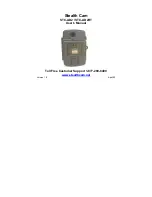
15
Indirect Flash Photography
The DAF-42 equipped with a bounce and swivel head which allows you to change the
direction of the flash up to 270° horizontally and up to 90° vertically. You can avoid
direct flashing onto objects by positioning the flash towards a reflection surface.
This surface should be neutrally white (e. g. white ceiling, white wall) as the light will
be reflected in the color of the surface flashed on. This leads to color distortions
when using colored reflecting surfaces. Indirect flash photography offers you the
following advantages:
• avoiding harsh shadows
• avoiding red eyes
• soft outlines and even illumination (particularly suitable for portraits)
• avoiding disturbing light reflections off non-metallic surfaces such as windows, glasses, or water.
On the backside of the flash you can read off the position of the bounce angle. When tilting the flash head,
no flash range is indicated on the LC display as the light path length does not comply with the distance to the
object but with the distance: flash- reflecting surface- object. Please consider that indirect flash photography
reduces the flash range. In TTL mode the flash and the camera automatically ensure proper dosage of the
flash´s power output. With indirect flash photography the power-zoom function is inactive. Please select the
focal length manually. Further the flash range, film speed and aperture are not indicated on the LC display.
Still, TTL flash control is active.
Indirect Flash Photography with Reflecting Plate
If you want to flash indirectly but no adequate reflection surface (white ceiling/white wall) is available, you
can use the built-in reflecting plate. One advantage to “regular” indirect flashing: The distance flash --->
reflecting surface ---> object is shorter. The reflecting plate is integrated in the flash head above the diffuser
plate. To use, slide it out until the stopper is reached.
Diffuser Plate
Especially with portraits a softer illumination is advantegous. Alternatively to indirect flashing this can also
be achieved by using a diffuser plate. The diffuser plate is integrated in the flash head beneath the reflecting
plate. To use, slide it out until the stopper is reached and the diffuser plate flaps over the reflector. Please
consider that the flash range reduces when using the diffuser plate. In TTL mode the flash and the camera
automatically ensure proper dosage of the flash´s power output. The reflecting plate is integrated in the flash
head above the diffuser plate. To use, slide it out until the stopper is reached.
Red-Eye Effect
With flash photography, the subject´s eyes may appear red in a picture. This is caused by flashlight reflecting
off the blood circulated retina. This phenomenon especially appears when the flash is located close to the
lens axis. Weak ambient light even supports the red-eye effect as the pupils will widen. A secure method to
avoid the red-eye effect is to use indirect flash photography. But even with direct flashing, the design of the
DAF-42 reduces the red-eye effect as the flash head is located as far as possible from the optical axis. The
larger the flash angle of incidence the lesser the red-eye effect.
Flash Synchronization
Digital Cameras: All shutter speeds can be used for flash photography. There are no restrictions.
Analog Cameras: Synchronization time refers to the shutter speeds which will allow flash photography.
Special attention must be paid in the case of short shutter speeds. Each camera model features a “shortest”
synchronization - the so-called x-synchronization. Please review the instruction manual of your camera.
















































